Most of the homes I inspect have garages with garage door openers. Today, the United States Consumer Product Safety Commission (CPS) announced a recall of approximately 10,000 Genie Garage Door Openers sold the U.S. While no injuries have been reported, there have been reports of the control board overheating in some units. If you have a Genie brand garage door opener, visit the CPS website at http://www.cpsc.gov/en/Recalls/2014/Genie-Recalls-Garage-Door-Openers/.
Professional home and commercial property inspection serving South Jersey, including Vineland, Hammonton, Millville, Mays Landing, Buena, and the New Jersey Shore. Home inspections with a personalized full-color inspection report. Christian Silvio, Certified by the International Association of Certified Home Inspectors. New Jersey Licensed Inspector: #24GI00119700.
Wednesday, February 26, 2014
Monday, February 24, 2014
Tips for Foreclosure Purchases
Buying a Foreclosure
by Nick Gromicko
Purchasing foreclosed homes in desirable areas at below-market values can be a sound investment strategy. Appreciation on their original prices may be tax-free. Buying foreclosed rental properties can provide positive cash flow, as well as valuable tax deductions. On the other hand, buying a foreclosure involves homework, patience, and a certain amount of luck. For those wishing to get a bargain house through the foreclosure process, it’s best to learn the basics.

Four Ways to Buy a Foreclosed Home
- A presale is when the prospective buyer negotiates with the current owner before the house is foreclosed upon. Presale discounts can be considerable, but communicating and reasoning with the owner isn’t always easy; they might have legal problems, lost their phone service or electricity, or greet you with suspicion, having already been hounded and threatened by creditors. And after time and energy have been invested, the deal can fall through if the owner comes up with the money to repay their debt, or for any number of unexpected reasons. With persistence, however, the seasoned real estate investor can profit from presales. To find out about presales, you can try one of the following avenues:
- Ask your local county court how to search new notices of default.
- Find out if the County Recorder has data available online.
- Look in the "legal notices" section of the newspaper for properties that are coming up for sale at public auction. Take note of the address, the property owner’s name, the tax ID, and whatever other information is contained in the ad.
- A foreclosed home may be sold at a public auction, in which buyers can expect a discount of 10% to 25% of market value. Interested bidders are generally required to show proof of financing, and must have a minimum cash deposit before they are qualified to bid. It might be impossible to gain entry to inspect the interior, too, which makes this type of purchase risky. The local building department may have permit records that can clue you in to the building’s layout and appearance.
- A real estate-owned (REO) sale is a transaction where a foreclosed house is purchased directly from the bank. These properties typically wound up in the bank’s portfolio after failing to sell at auction. REO investments are relatively safe, as there are no tenants to evict or hidden liens and, unlike properties sold at public auction, buyers can usually receive a mortgage to pay for them. And purchasers might even get an unused house; the slow economy has left many builders at the end of their construction-loan periods without finding buyers for the homes, in which case the bank will foreclose on the brand new homes. Unfortunately, REOs are usually offered at near-market prices to recoup the costs of property taxes, maintenance and legal fees. To find REOs, try the following:
- Check lenders’ websites, as they may have a list of their REOs, along with contact information for the appropriate real estate agent.
- Call lenders and ask to speak to someone who handles their foreclosures.
- Check newspapers.
- The Department of Housing and Urban Development has tens of thousands of HUD homes whose previous owners defaulted on federally issued loans. After a period during which local governments gain exclusive buying privileges, they become available to individual buyers who pledge to live in the property. After another 10 days, investors may bid on the property. It’s difficult to make a profit on these houses, as HUD releases them at near-market values.
Tips for Foreclosure Purchases
- Invest time in research and preparation. Those new to the field should spend some time learning the variables of foreclosure investing before making any purchases.
- Budget carefully to prepare for the unexpected. The house may require unforeseen repairs, such as a leaky roof or unstable deck. The price tag of the home itself is often just the first of a series of fees. What if you planned on rental cash flow to cover the mortgage, but you can’t find a tenant?
- Avoid buying a foreclosure sight-unseen. Try to see the house yourself before buying it, or hire someone to evaluate at it in your absence. Distant investors are buying up properties unseen in bulk, and they’re often unpleasantly surprised at how much they’ve been misled.
- Evaluate the neighborhood. If the foreclosure is rife with problems, but it’s in a desirable area with high property resale values, it may still be worth it to make a low offer. An area with several foreclosures or a high crime rate can undermine an otherwise good deal, however.
- Consider how long the house has been vacant. Building damage – and the costs required to make the house livable - generally increases with the time that has lapsed since the last tenant vacated. Pests are a particular issue in houses that have been empty for a long time, and plumbing defects and leaks increase in likelihood in such homes, as well.
- Examine the landscaping. Left unchecked, trees can send their roots into the foundation, and vines can creep into the windows.
- Has the house been professionally inspected by an InterNACHI inspector? Foreclosures can be notorious for damage suffered at the hands of past tenants, through both inadvertent and intentional vandalism and theft.
In summary, there are a number of ways to go about buying a foreclosed home, and buyers should exercise patience, persistence and careful planning before buying foreclosed properties.
Monday, February 17, 2014
Safety in the Kitchen - Anti-Tip Ovens/Ranges
Anti-Tip Brackets for Freestanding Ranges
by Nick
Gromicko and Kenton Shepard
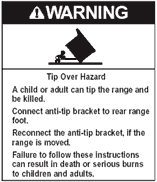
Anti-tip
brackets are metal devices designed to prevent freestanding ranges
from tipping. They are normally attached to a rear leg of the range
or screwed into the wall behind the range, and are included in all
installation kits. A unit that is not equipped with these devices may
tip over if enough weight is applied to its open door, such as that
from a large Thanksgiving turkey, or even a small child. A falling
range can crush, scald, or burn anyone caught beneath.
Bracket
Inspection
Inspectors
can confirm the presence of anti-tip brackets through the following
methods:
- It may be possible to see a wall-mounted bracket by looking over the rear of the range. Floor-mounted brackets are often hidden, although in some models with removable drawers, such as 30-inch electric ranges made by General Electric, the drawers can be removed and a flashlight can be used to search for the bracket. Inspectors should beware that a visual confirmation does not guarantee that the bracket has been properly installed.
- Inspectors can firmly grip the upper-rear section of the range and tip the unit. If equipped with an anti-tip bracket, the unit will not tip more than several inches before coming to a halt. The range should be turned off, and all items should be removed from the stovetop before this action can be performed. It is usually easier to detect a bracket by tipping the range than through a visual search. This test can be performed on all models and it can confirm the functionality of a bracket.
If no
anti-tip bracket is detected, inspectors should recommend that one be
installed.
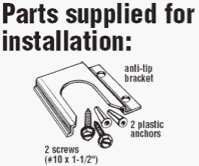 Clients
can contact the dealer or builder who installed their range and
request that they install a bracket. For clients who wish to install
a bracket themselves, the part can be purchased at most hardware
stores or ordered from a manufacturer. General Electric will send
their customers an anti-tip bracket for free.
Clients
can contact the dealer or builder who installed their range and
request that they install a bracket. For clients who wish to install
a bracket themselves, the part can be purchased at most hardware
stores or ordered from a manufacturer. General Electric will send
their customers an anti-tip bracket for free.
According
to the U.S. Consumer Product Safety Commission (CPSC), there were 143
incidents caused by range tip-overs from 1980 to 2006. Of the 33
incidents that resulted in death, most of those victims were
children. A small child may stand on an open range door in order to
see what is cooking on the stovetop and accidentally cause the entire
unit to fall on top of him, along with whatever hot items may have
been cooking on the stovetop. The elderly, too, may be injured while
using the range for support while cleaning.
In
response to this danger, the American National Standards Institute
(ANSI) and Underwriters Laboratories (UL) created standards in 1991
that require all ranges manufactured after that year to be capable of
remaining stable while supporting 250 pounds of weight on their open
doors. Manufacturers' instructions, too, require that anti-tip
brackets provided be installed. Despite these warnings, retailer
Sears estimated in 1999 that a mere 5% of the gas and electric units
they sold were ever equipped with anti-tip brackets. As a result of
Sears’ failure to comply with safety regulations, they were sued
and subsequently required to secure ranges in nearly 4 million homes,
a measure that has been speculated to have cost Sears as much as $500
million.
In
summary, ranges are susceptible to tipping if they are not equipped
with anti-tip brackets. Inspectors should know how to confirm that
these safety devices are present.
Los soportes antivolcados para las estufas independientes
Los soportes antivolcados para las estufas independientes
por Nick Gromicko y Kenton Shepard

Los soportes antivolcados son los aparatos metálicos diseñados para evitar las estufas independientes de volcar. Ellos son normalmente sujetados a la pierna trasera de una estufa o atornillados a la pared detrás de la estufa, y son incluidos en todos los equipos de instalación. Una unidad que no está equipada con aquellos aparatos se puede volcar si suficiente peso es aplicado a su puerta abierta, tal como el de un pavo grande del día de Acción de Gracias, o hasta un niño pequeño. Una estufa en caída puede aplastar, escaldar o quemar a cualquiera persona atrapado debajo.
La inspección de soportes antivolcados
Los inspectores pueden confirmar la presencia de los soportes antivolcados a través de los métodos siguientes:
- Puede ser posible a ver un soporte montado en la pared al mirar la parte trasera de la estufa. Los soportes antivolcados montados en el piso son muchas veces escondidos, aunque en algunos modelos con los cajones desmontables, tal como las estufas eléctricas de 30" (76.2 cm) hechas por General Electric, los cajones pueden ser desmontados y una linterna puede ser utilizado para buscar por el soporte. Los inspectores deberían de saber que una confirmación visual no garantiza que el soporte ha sido instalado apropiadamente.
- Los inspectores pueden agarrar firmemente la sección de parte trasera superior de la estufa y volcar la unidad. Si la unidad está equipada con un soporte antivolcado, no volcará más que unas pulgadas antes de su paro. La estufa debería de estar apagada, y todos los artículos deberían de ser quitados de la estufa antes de que esta acción pueda ser desempeñada. Por lo general, es más fácil de detectar un soporte antivolcado por volcar la estufa que por una búsqueda visual. Esta prueba puede ser desempeñada en todos los modelos y puede confirmar la funcionalidad de un soporte antivolcado.
Si ningún soporte antivolcado es detectado, los inspectores deberían de recomendar que uno sea instalado. Los clientes pueden contactar el comerciante o el albañil que instaló su estufa y pedir que ellos instalen un soporte. Para los clientes quienes desean a instalar un soporte antivolcados ellos mismos, la parte puede ser comprada en casi todas las tiendas de ferretería u ordenada de un fabricante. El General Electric mandará a sus clientes un soporte antivolcado por gratis.

Según la CPSC de los Estados Unidos (la Comisión para la Seguridad de los Productos de Consumo), habían 143 incidentes causados por los volcados de estufas desde 1980 a 2006. De los 33 incidentes que resultaron en muerte, la mayoría de estas víctimas fueron niños. Un niño pequeño puede ponerse de pie en la puerta abierta de la estufa para ver qué está siendo cocinado y accidentalmente causar la unidad entera a caer encima de él, incluso cualquiera cosa caliente que estaba siendo cocinado en la estufa. Las personas mayores, también, pueden ser heridas al utilizar la estufa como un apoyo a la hora de limpiar.
En respuesta a este peligro, el ANSI (El Instituto Nacional Estadounidense de Estándares) y UL, la organización que certifica la seguridad de productos, crearon los estándares en 1991 que requiere que todas las estufas fabricadas después de este año sean capaces de permanecer estable mientras sosteniendo 250 libras (113.6 kg) de peso en sus puertas abiertas. Las instrucciones de fabricantes, también, requieren que los soportes antivolcados proveídos sean instalados. A pesar de estas advertencias, minorista Sears calculó en 1999 que un mero 5% de las unidades de gas y eléctricas ellos vendieron fueron equipados con soportes antivolcados. Como un resultado del fracaso de Sears a cumplir con las regulaciones de la seguridad, ellos fueron demandados y posteriormente requeridos a asegurar las estufas en casi 4 millones de casas, una medida que ha sido especulada a haber costado Sears tanto como 500 millones de dólares.
En resumen, las estufas son susceptibles a volcar si no están equipadas con los soportes antivolcados. Los inspectores deberían de saber de cómo confirmar que estos aparatos de la seguridad están presentes.
Friday, February 14, 2014
Water Intrusion - Basic Waterproofing
Basic Waterproofing for Basements
by Nick Gromico and Ethan Ward
Water Damage Concerns
 Water
can even migrate through solid concrete walls via capillary action,
which is a phenomenon whereby liquid spontaneously rises in a narrow
space, such as a thin tube, or via porous materials. Wet basements can
cause problems that include peeling paint, toxic mold contamination,
building rot, foundation collapse, and termite damage. Even interior
air quality can be affected if naturally occurring gasses released by
the soil are being transmitted into the basement.
Water
can even migrate through solid concrete walls via capillary action,
which is a phenomenon whereby liquid spontaneously rises in a narrow
space, such as a thin tube, or via porous materials. Wet basements can
cause problems that include peeling paint, toxic mold contamination,
building rot, foundation collapse, and termite damage. Even interior
air quality can be affected if naturally occurring gasses released by
the soil are being transmitted into the basement. Properly waterproofing a basement will lessen the risk of damage caused by moisture or water. Homeowners will want to be aware of what they can do to keep their basements dry and safe from damage. Inspectors can also benefit from being aware of these basic strategies for preventing leaks and floods.
Prevent water entry by diverting it away from the foundation.
Preventing water from entering the basement by ensuring it is
diverted away from the foundation is of primary concern. Poor roof
drainage and surface runoff due to gutter defects and improper site
grading may be the most common causes of wet basements. Addressing
these issues will go a long way toward ensuring that water does not
penetrate the basement.

Here are some measures to divert water away from the foundation:
- Install and maintain gutters and downspouts so that they route all
rainwater and snow melt far enough away from the foundation of the
building to ensure that pooling does not occur near the walls of the
structure. At least 10 feet from the building is best, and at the point
where water leaves the downspout, it should be able to flow freely away
from the foundation instead of back toward it, and should not be
collecting in pools.
- The finish grade should be sloped away from the building for 10 to
15 feet. Low spots that may lead to water pooling should be evened out
to prevent the possibility of standing water near the foundation.
- Shallow ditches called swales should be used in conditions where one or more sides of the building face an upward slope.
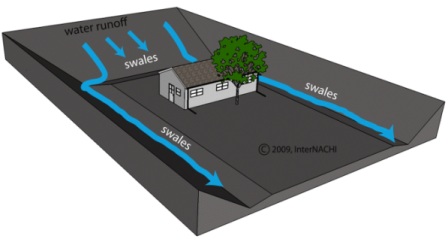 A swale should slope away from the building for 10 to 15 feet, at which
point it can empty into another swale that directs water around to the
downhill-side of the building, leading it away from the foundation.
A swale should slope away from the building for 10 to 15 feet, at which
point it can empty into another swale that directs water around to the
downhill-side of the building, leading it away from the foundation.
Repair all cracks and holes.
If leaks or seepage is occurring in the basement's
interior, water and moisture are most likely entering through small
cracks or holes. The cracks or holes could be the result of several
things. Poor workmanship during the original build may be making itself
apparent in the form of cracks or holes. Water pressure from the
outside may be building up, forcing water through walls. The house may
have settled, causing cracks in the floor or walls. Repairing all
cracks and small holes will help prevent leaks and floods.
Here are some steps to take if you suspect that water is entering the basement through cracks or holes:
- Identify areas where water may be entering through cracks or holes
by checking for moisture, leaking or discoloration. Every square inch
of the basement should be examined, especially in cases where leaking or
flooding has not been obvious, but moisture buildup is readily
apparent.
- A mixture of epoxy and latex cement can be used to fill small
hairline cracks and holes. This is a waterproof formula that can help
ensure that moisture and water do not penetrate basement walls. It is
effective primarily for very small cracks and holes.
- Any cracks larger than about 1/8-inch should be filled with mortar
made from one part cement and two parts fine sand, with just enough
water to make a fairly stiff mortar.
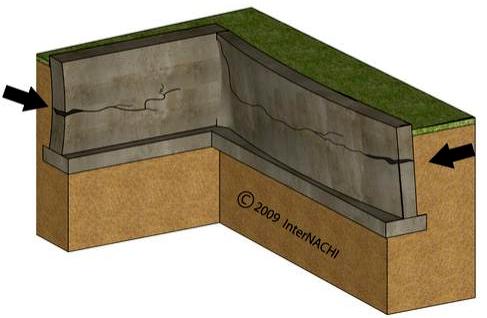 It
should be pressed firmly into all parts of the larger cracks and holes
to be sure that no air bubbles or pockets remain. As long as water is
not being forced through basement walls due to outside pressure,
the application of mortar with a standard trowel will be sufficient if
special care is taken to fill all cracks completely.
It
should be pressed firmly into all parts of the larger cracks and holes
to be sure that no air bubbles or pockets remain. As long as water is
not being forced through basement walls due to outside pressure,
the application of mortar with a standard trowel will be sufficient if
special care is taken to fill all cracks completely.
- If water is being forced through by outside pressure, a slightly different method of patching with mortar can be used. Surface areas of walls or floors with cracks should first be chiseled out a bit at the mouth of the crack and all along its length. Using a chipping chisel and hammer or a cold chisel, cut a dovetail groove along the mouth of each crack to be filled, and then apply the mortar thoroughly. The dovetail groove, once filled, should be strong enough to resist the force of pressure that was pushing water through the crack.
Once all runoff has been thoroughly diverted away from the foundation, and all cracks and holes have been repaired and no leaking is occurring, a waterproof sealant can be applied as a final measure.
Sodium silicate is a water-based mixture that will actually
penetrate the substrate by up to 4 inches. Concrete, concrete block and
masonry have lime as a natural component of their composition, which
reacts with the sodium silicate to produce a solid, crystalline
structure which fills in all the microscopic cracks, holes and pores of
the substrate. No water vapor or gas will be able penetrate via
capillary action because the concrete and masonry have now become harder
and denser from the sodium silicate.
Here are some steps and tips for its application:
- Special care should be taken when applying sodium silicate. It is
an alkaline substance and, as such, can burn skin and eyes if it comes
into contact with them. Inhalation can also cause irritation to the
respiratory tract.
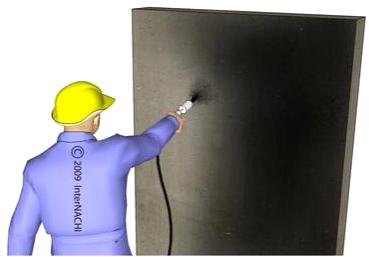
- Sodium silicate must be applied only to bare concrete, concrete
block or masonry that has been cleaned thoroughly and is free of any
dirt, oil, adhesives, paint and grease. This will ensure that it
penetrates the substrate properly and fills in all microscopic cracks.
It can be applied using a garden sprayer, roller or brush to a surface
that has first been lightly dampened with a mop or brush. Apply two to
three coats to the concrete, waiting 10 to 20 minutes between each
application. Concrete block and masonry will take three to four coats,
with the same 10 to 20 minutes between applications. Any excess should
then be wiped away. Sodium silicate should not be over-applied or it
will not be completely absorbed by the substrate, leaving a white
residue.
- Paint can then be applied without fear of water vapor getting trapped between the paint and the wall, which could eventually cause blistering and peeling. Adhesives for tile or floor covering can also be used more effectively, once the substrate has been sealed.
Diverting water away from foundations so that it does not collect
outside basement walls and floors is a key element in preventing
flooding and water damage. Ensuring that any water that does end up
near basement exteriors cannot enter through holes or cracks is also
important, and sealing with a waterproof compound will help prevent
water vapor or gas from penetrating, as well. By following these
procedures, the risk of water-related issues in basement interiors can
be greatly reduced, protecting the building from damage such
as foundation rotting, mold growth, and peeling paint, as well as
improving the interior air quality by blocking the transmission of
gasses from the soil outside.
Thursday, February 13, 2014
Space Heaters
Energy-Efficient Space Heaters
by Nick Gromicko and Ethan
Ward
Why
use space heaters?
Small, portable space
heaters are often used when the main heating system is inadequate, or
when it would be too costly to operateor install central heating.
They can also be useful to supplement adequate central heating in
certain instances, such as heating one room that will be primarily
occupied while lowering the thermostat on the central system so that
heat is not wasted in unoccupied rooms. In some cases, it is possible
to lower total heating costs by up to 10%, as well as reduce
CO2emissions by up to 800 pounds, by using space heaters in this
manner.
Different
Types of Space Heaters
Understanding some of the
differences between the types of space heaters and how they work can
be helpful when deciding what the most efficient and effective
options are for a given situation. Below are descriptions of some of
the main types of heaters available:
coil-based convection heaters: This type of heater uses a fan to push air into a room that has been heated internally by passing through hot metal coils. These heaters utilize a safety mesh in order to ensure that nothing in the room will come into contact with the internal heating elements.
- ceramic-element heaters: This type is generally considered safer to operate than a coil-based unit. Since the ceramic core is larger than heating coils, these units can operate at a lower temperature while providing an equivalent amount of heat that spreads over a farther area. This type of heater is also able to maintain a higher temperature for a longer period of time c
ompared to a coil-based unit, which makes it more efficient.
- oil-filled
radiators:These
heaters are highly efficient and operate silentlybecause they do not
use a fan. Instead, they use fluid contained in a permanently sealed
radiator apparatus, which does not ever need to be refilled. The oil
is heated within the unit, and the heat from the oil then radiates
into the room. Once heated, the oil will continue to
graduallyrelease warmth into the room even when the internal heating
element is turned off.
- halogen
lamp heaters: Energy-efficient
halogen bulbs are used in these types of space heaters to provide
instant warmth at the touch of a button. They are made safe by
employing safety grilles and cool cabinets, and can be especially
appropriate in areas where small children or pets are of concern.
Estimating
the Cost of Operation
The operational costs of
space heaters depend on the type of heater in use, as well as the
room it is being used to heat. "Kilowatts x Rate x Time = Cost"
is a useful formula, in general,to determine how much a heater will
cost to run. Here is how the formual breaks down:

- kilowatts: the setting of the heater. Divide watts by 1,000 to get kilowatts per hour;
- rate: the cost of electricity per kilowatt-hour, which can be determined for an area by contacting the local utility company; and
- time:
the amount of time the heater is in use.
For example, a 1,500-watt
space heater running for 10 hours at a rate of $0.10 per
kilowatt-hour will cost $1.50. Using the formula:
Kilowatts x Rate x Time =
Cost,
the usage can be figured as:
(1,500w ÷ 1,000) x
$0.10 kWh x 10 hours = $1.50.
Space
Heater Safety
Since space heaters can
generate extreme temperatures at the surface, they have the potential
to be dangerousand even cause injury. Although they are safe when
operated correctly, it is estimated that 25,000 residential fires and
300 deaths are associated with the use of space heaters every year.
When using a portable space heater, following these safety
precautions, as well as any guidelines recommended by the
manufacturer of the unit, can lessen the risk of accident or injury.
- Use only the type of fuel or energy intended for use with the specific device. The use of gasoline in a kerosene heater, for example, would be very dangerous.
- Never attempt to repair or replace parts in a heater yourself. This should always be handled by a qualified service center, since the results of repairing a malfunctioning unit could be dangerous.
- Use of extension cords for the power supply should be avoided. A cord marked 14 or 12 AWG can be used if absolutely necessary.
- Do not use space heaters in wet or moist areas, such as in a bathroom.
- Always keep heaters level and on the floor. If a heater has been placed on furniture and it falls off, or if a table it has been placed on collapses, the damage to the unit could result in a fire or shock hazard. Some units contain a tip-over switch which automatically shuts the power off if the unit is knocked over, but even these should be situated in such a way that they will not be at risk of falling over.
- If the surface of the unit has a high operating temperature, there should be a guard around the heating element to keep people, pets and combustibles a safe distance away from it.
- The unit should have an indicator light to signal when it is plugged in or turned on.
- Be sure to install the correct size unit for the space to be heated. Too large or small of a unit may actually decrease energy efficiency, or could cause pollutants.
Other
Factors to Consider
When considering the use of
a space heater, especially for the purpose of improved energy
efficiency, there are several final factors to consider. Space
heaters will only impact energy efficiency in a positive way if they
allow for the home's main thermostats to be turned down.I f
a space heater is used simply in addition to central heat without
lowering the central thermostat, it will only add to energy bills.
f
a space heater is used simply in addition to central heat without
lowering the central thermostat, it will only add to energy bills.
 f
a space heater is used simply in addition to central heat without
lowering the central thermostat, it will only add to energy bills.
f
a space heater is used simply in addition to central heat without
lowering the central thermostat, it will only add to energy bills.
Here are some other things
to take into consideration when deciding whether a space heater will
be right for a given situation, and which type of space heater will
work best.
- What area of the building will the heater be used in? Be sure to select an appropriate unit for the area, and carefully consider whether this area will really benefit from use of a portable heater to begin with. For example, heating a room thatis generally too cold but not often used anyway would simply suck energy without much return on savings.
- Space heaters that include a thermostat are more efficient than models that do not.
- If the unit doesn't have a thermostat, utilize the different settings onit for maximum efficiency. Once a heater has adequately heated a room at full power, turn the setting lower to maintain current levels, rather than adding more heat toan already warmed room.
- Select a heater with appropriate safety features for the application. For example, a heater that achieves extremely hot surface temperatures may not be a good choice in an area where small children are present.
- The surface temperature of the heater can also be an issue in areas where combustibles might be found in close proximity to the unit.
- Some units that use a fan can be noisy, which may be an issue in certain circumstances, and should be taken into account during the selection process.
Space
heaters can be effective energy-savers under the right circumstances,
and different types of units will perform better in different
situations. Knowing a bit about acceptable applications, as well as
the properties of different designs, can be helpful in deciding if
the use of a space heater will be a good choice for a home.
Tuesday, February 11, 2014
Inspect Before You Sell
Sellers' Pre-Listing Inspections
Eventually, a buyer is going to conduct an inspection. You may as well know what they are going to find by getting there first.
Having an inspection performed ahead of time helps in many other ways, such as:
- It allows you to see your home through the eyes of a critical and neutral third party.
- It alerts you to immediate safety issues before agents and visitors tour your home.
- It may alert you to items of immediate concern, such as radon gas or active termite infestation.
- It permits you to make repairs ahead of time so that ...
- Defects won't become negotiating stumbling blocks later.
- There is no delay in obtaining the Use and Occupancy Permit.
- You have the time to get reasonably priced contractors or make the repairs yourself, if qualified.
- It helps you to price your home realistically.
- It may relieve prospects' concerns and suspicions.
- It may encourage the buyer to waive his inspection contingency.
- It reduces your liability by adding professional supporting documentation to your disclosure statement.
Never hire an inspector who is not a member of InterNACHI, which provides the most trusted and rigorous training for inspectors in the industry.
Copies of the inspection report, along with receipts for any repairs, should be made available to potential buyers.
Subscribe to:
Comments (Atom)